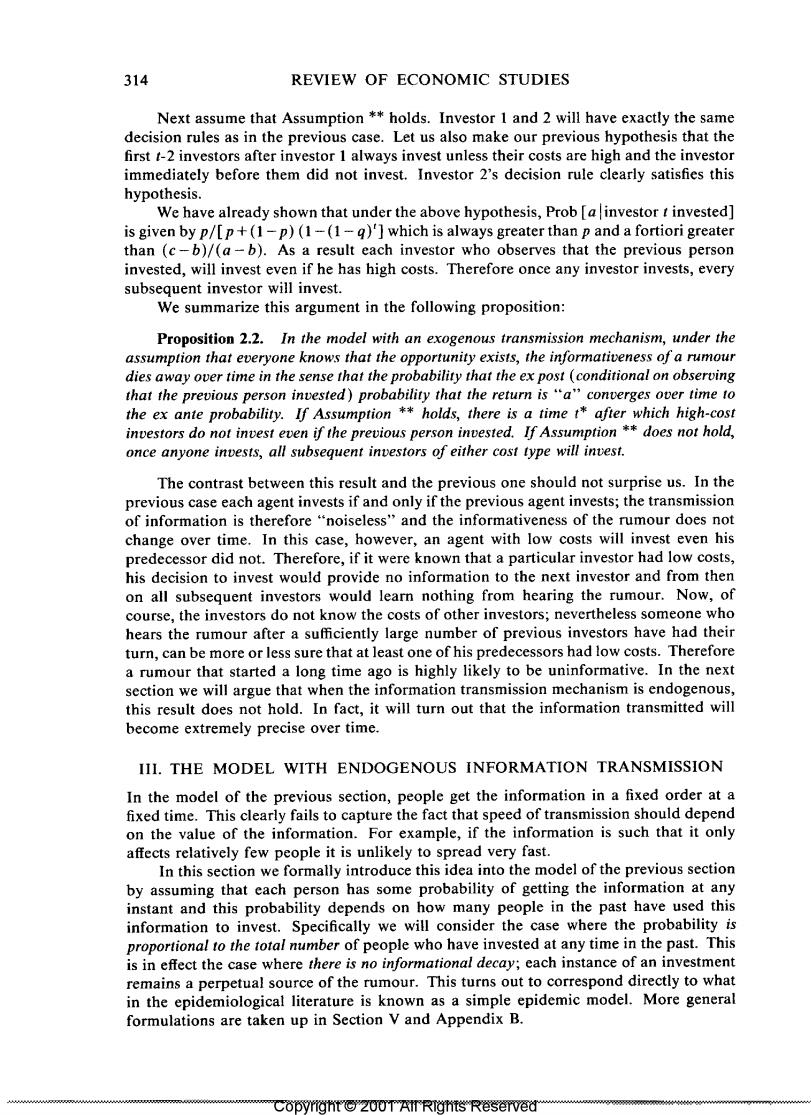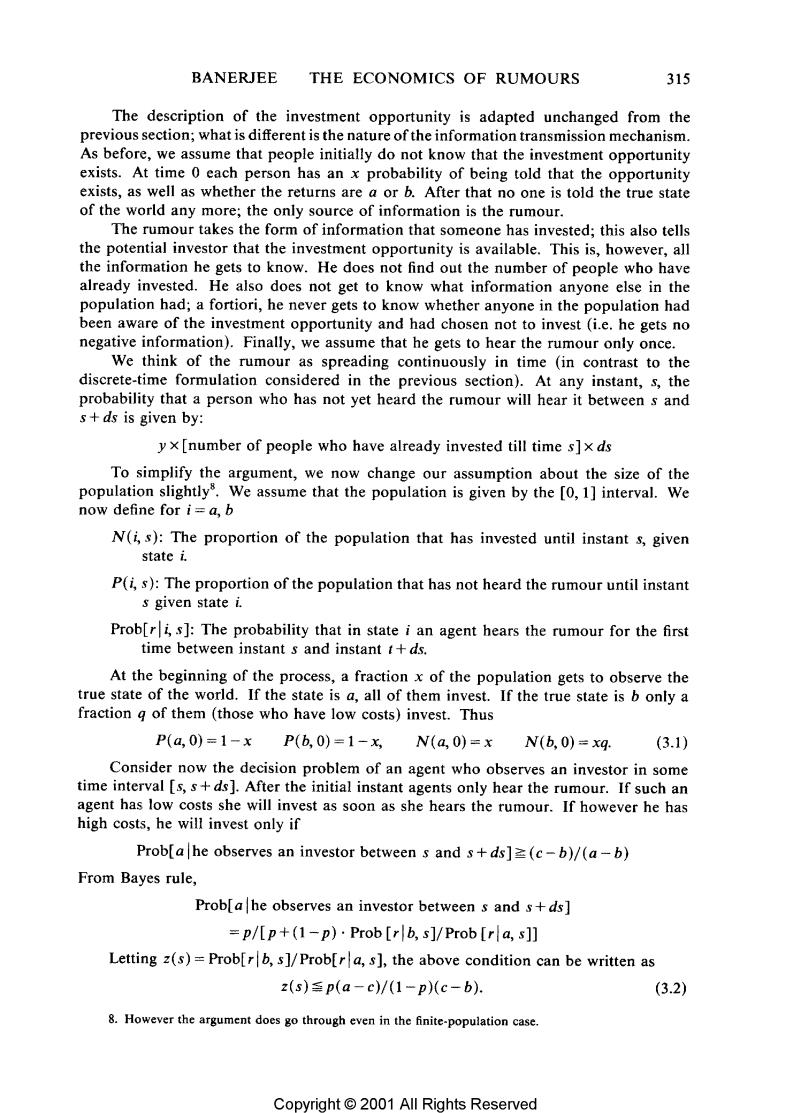
314 REVIEW OF ECONOMIC STUDIES Next assume that Assumption**holds.Investor 1 and 2 will have exactly the same decision rules as in the previous case.Let us also make our previous hypothesis that the first t-2 investors after investor 1 always invest unless their costs are high and the investor immediately before them did not invest.Investor 2's decision rule clearly satisfies this hypothesis. We have already shown that under the above hypothesis,Prob [ainvestor t invested] is given by p/[p+(1-p)(1-(1-q)]which is always greater than p and a fortiori greater than (c-b)/(a-b).As a result each investor who observes that the previous person invested,will invest even if he has high costs.Therefore once any investor invests,every subsequent investor will invest. We summarize this argument in the following proposition: Proposition 2.2.In the model with an exogenous transmission mechanism,under the assumption that everyone knows that the opportunity exists,the informativeness of a rumour dies away over time in the sense that the probability that the ex post (conditional on observing that the previous person invested)probability that the return is"a"converges over time to the ex ante probability.If Assumption *holds,there is a time t*after which high-cost investors do not invest even if the previous person invested.If Assumption *does not hold, once anyone invests,all subsequent investors of either cost type will invest. The contrast between this result and the previous one should not surprise us.In the previous case each agent invests if and only if the previous agent invests;the transmission of information is therefore "noiseless"and the informativeness of the rumour does not change over time.In this case,however,an agent with low costs will invest even his predecessor did not.Therefore,if it were known that a particular investor had low costs, his decision to invest would provide no information to the next investor and from then on all subsequent investors would learn nothing from hearing the rumour.Now,of course,the investors do not know the costs of other investors;nevertheless someone who hears the rumour after a sufficiently large number of previous investors have had their turn,can be more or less sure that at least one of his predecessors had low costs.Therefore a rumour that started a long time ago is highly likely to be uninformative.In the next section we will argue that when the information transmission mechanism is endogenous, this result does not hold.In fact,it will turn out that the information transmitted will become extremely precise over time. III.THE MODEL WITH ENDOGENOUS INFORMATION TRANSMISSION In the model of the previous section,people get the information in a fixed order at a fixed time.This clearly fails to capture the fact that speed of transmission should depend on the value of the information.For example,if the information is such that it only affects relatively few people it is unlikely to spread very fast. In this section we formally introduce this idea into the model of the previous section by assuming that each person has some probability of getting the information at any instant and this probability depends on how many people in the past have used this information to invest.Specifically we will consider the case where the probability is proportional to the total number of people who have invested at any time in the past.This is in effect the case where there is no informational decay;each instance of an investment remains a perpetual source of the rumour.This turns out to correspond directly to what in the epidemiological literature is known as a simple epidemic model.More general formulations are taken up in Section V and Appendix B. BAAAAAAA333833AA00000 Copyrignt o 200T All RIgnts Reserved

BANERJEE THE ECONOMICS OF RUMOURS 315 The description of the investment opportunity is adapted unchanged from the previous section;what is different is the nature of the information transmission mechanism. As before,we assume that people initially do not know that the investment opportunity exists.At time 0 each person has an x probability of being told that the opportunity exists,as well as whether the returns are a or b.After that no one is told the true state of the world any more;the only source of information is the rumour. The rumour takes the form of information that someone has invested;this also tells the potential investor that the investment opportunity is available.This is,however,all the information he gets to know.He does not find out the number of people who have already invested.He also does not get to know what information anyone else in the population had;a fortiori,he never gets to know whether anyone in the population had been aware of the investment opportunity and had chosen not to invest(i.e.he gets no negative information).Finally,we assume that he gets to hear the rumour only once. We think of the rumour as spreading continuously in time (in contrast to the discrete-time formulation considered in the previous section).At any instant,s,the probability that a person who has not yet heard the rumour will hear it between s and s+ds is given by: yx[number of people who have already invested till time s]x ds To simplify the argument,we now change our assumption about the size of the population slightly We assume that the population is given by the [0,1]interval.We now define for i=a,b N(i,s):The proportion of the population that has invested until instant s,given state i. P(i,s):The proportion of the population that has not heard the rumour until instant s given state i. Prob[ri,s]:The probability that in state i an agent hears the rumour for the first time between instant s and instant t+ds. At the beginning of the process,a fraction x of the population gets to observe the true state of the world.If the state is a,all of them invest.If the true state is b only a fraction g of them (those who have low costs)invest.Thus P(a,0)=1-xP(b,0)=1-x,N(a,0)=xN(b,0)=xg (3.1) Consider now the decision problem of an agent who observes an investor in some time interval [s,s+ds].After the initial instant agents only hear the rumour.If such an agent has low costs she will invest as soon as she hears the rumour.If however he has high costs,he will invest only if Prob[a he observes an investor between s and s+ds]=(c-b)/(a-b) From Bayes rule, Prob[ahe observes an investor between s and s+ds] p/[p+(1-p).Prob[r|b,s]/Prob [r a,s]] Letting z(s)=Prob[r b,s]/Prob[ra,s],the above condition can be written as z(s)=p(a-c)/(1-p)(c-b). (3.2) 8.However the argument does go through even in the finite-population case. Copyright 2001 All Rights Reserved